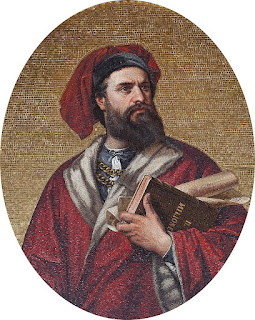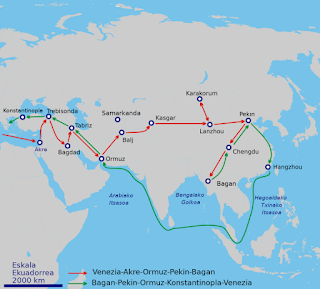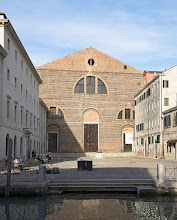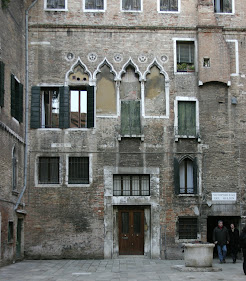Marco Pantani - tragic cycling champion
Rider from Cesenatico won historic 'double'
Marco Pantani, the last rider to have won cycling's Giro d'Italia and the Tour de France in the same year, was born on this day in 1970. Recognised as one of the sport's greatest hill climbers, Pantani completed the historic 'double' in 1998 and remains one of only seven riders to achieve the feat. A single-mindedly fierce competitor, Pantani had won the amateur version of the Giro - the Girobio - in 1992, after which he turned professional. Winner of the Young Rider classification at the Tour de France in 1994 and 1995, he might have enjoyed still greater success. But Pantani's career was blighted by physical injuries and later by scandal after he was disqualified from the 1999 Giro d'Italia just two days from the finish - and with a clear lead - after a blood test revealed irregular results. He died tragically young in 2004. Growing up, Pantani's home town was the port of Cesenatico, on the Adriatic Coast, about 30 minutes' drive away from Cesena, in Emilia-Romagna. His mother worked as a chambermaid in hotels in Cesenatico and in neighbouring Bellaria, while his father, Paolo, was an engineer. Read more…
________________________________________
Costa Concordia tragedy
Shipwreck off Tuscany coast cost 32 lives
A fatal accident involving the luxury cruise ship Costa Concordia took place on this day in 2012, resulting in the loss of 32 lives. The captain, Francesco Schettino, was ultimately prosecuted and found guilty of manslaughter, receiving a 16-year jail sentence. The tragedy began to unfold at 9.45pm as the €450 million vessel, carrying 3,206 passengers and 1,023 crew, struck rocks close to Isola del Giglio, off the coast of southern Tuscany. The Costa Concordia, at 290m long Italy’s largest cruise ship when launched in 2005, was en route from the Tyrrhenian port of Civitavecchia to Savona in Liguria on the first leg of a seven-day Mediterranean cruise. Its course along the Italian coastline involved passing between Isola del Giglio, an island of 23.80 sq km (9.19 sq mi), and the promontory of Monte Argentario, some 16km (10 miles) to the east, but well away from the coastline of each. On the night of 13 January, 2012, however, the Costa Concordia deviated considerably from its normal course after Schettino ordered the ship to be steered close to Isola del Giglio in a manoeuvre known as a maritime “salute” to the island’s 1,400 residents, sounding the ship’s horns as it brushed the shore. Read more…
______________________________________
Renato Bruson – operatic baritone
Donizetti and Verdi specialist rated among greats
The opera singer Renato Bruson, whose interpretation of Giuseppe Verdi’s baritone roles sometimes brought comparison with such redoubtable performers as Tito Gobbi, Ettore Bastianini and Piero Cappuccili, was born on this day in 1936 in the village of Granze, near Padua. Bruson’s velvety voice and noble stage presence sustained him over a career of remarkable longevity. He was still performing in 2011 at the age of 75, having made his debut more than half a century earlier. Since then he has devoted himself more to teaching masterclasses, although he did manage one more performance of Verdi’s Falstaff, which was among his most famous roles, at the age of 77 in 2013, having been invited to the Teatro Verdi in Busseto, the composer’s home town in Emilia-Romagna, as part of a celebration marking 200 years since Verdi’s birth. In later life, he continued to work as director of the Accademia Lirica at Teatro alla Scala in Milan, a role he combined with a professorship at the Accademia Chigiana in Siena and a post at the lyrical academy in Spoleto. It was at the Teatro Lirico Sperimentale in Spoleto, the ancient city in Umbria, that Bruson made his stage debut. Read more…
______________________________________
Veronica De Laurentiis - actress and author
Turned personal torment into bestselling book
The actress and author Veronica De Laurentiis, the daughter of legendary film producer Dino De Laurentiis and actress Silvana Mangano, was born on this day in 1950 in Rome. Although she still works in film and TV, she is best known as a campaigner against domestic violence and the author of the bestselling book Rivoglio la mia vita (I Want My Life Back), which revealed details of the attacks she was subjected to in her first marriage. Her then-husband was subsequently jailed for 14 years. Veronica De Laurentiis was cast in the blockbuster movie Waterloo - produced by her father - when she was just 18, alongside the great actors Rod Steiger and Christopher Plummer. She married young, and after the birth of her first child, Giada - now well known as a TV cook in the United States - decided to suspend her acting career in order to focus on parenthood. With her husband, she lived in Italy until after the birth of her third child, at which point they moved to America, living first in Florida, then New York and finally in Los Angeles. They divorced four years after the birth of their fourth child, after which Veronica sustained herself by setting up a fashion design studio in Los Angeles. Read more…
_____________________________________
Prince Emanuele Filiberto – Duke of Aosta
Savoy prince who became a brilliant soldier
Prince Emanuele Filiberto, who became the second Duca d'Aosta - Duke of Aosta - was born on this day in 1869 in Genoa. The Prince successfully commanded the Italian Third Army during World War I, earning himself the title of the ‘Undefeated Duke.’ After the war he became a Marshall of Italy. Emanuele Filiberto was the eldest son of Prince Amedeo of Savoy, Duca d'Aosta, and his first wife, Donna Maria Vittoria dal Pozzo della Cisterna, an Italian noblewoman. In 1870 Prince Amedeo was elected to become King of Spain but he resigned after three years on the throne and returned to Italy, declaring Spain ‘ungovernable’. In 1890 Emanuele Filiberto succeeded his father to the title of Duca d'Aosta. The Duke began his army career in Naples in 1905 as a Commander. His record while in command of the Italian Third Army led to his troops being nicknamed ‘armata invitta’ - undefeated army - despite some of the heavy losses suffered by Italian troops under other commanders during World War I. After the war, in 1926, he was promoted to the rank of Marshal of Italy by Benito Mussolini in recognition of his long and successful service to his country. Read more…
_______________________________________
Carlo Tagliabue – opera singer
Powerful performer remembered for his Don Carlo
A leading Italian baritone in the middle of the 20th century, Carlo Tagliabue was born on this day in 1898 in Mariano Comense near Como in Lombardy. He particularly excelled in Verdi roles at the height of his career and continued to perform on stage and make recordings when he was well into his fifties. After studying in Milan, Tagliabue made his debut on stage at a theatre in Lodi in 1922 singing Amonasro, King of Ethiopia, in Aida. He went on to sing in Richard Wagner’s Tristan und Isolde, when it was performed in Italian at theatres in Genoa, Turin , Milan , Rome and Naples. He later became known for his performances in Giuseppe Verdi operas, particularly La forza del destino, Rigoletto, La traviata, Nabucco and Otello and he was consistently praised for the power of his voice. Tagliabue is also remembered for creating the role of Basilio in the world premiere of Ottorino Respighi’s La fiamma in 1934. He went on to sing in Buenos Aires, New York, San Francisco and London but his final performance was in 1955 on the stage of La Scala in Milan as Don Carlo in La forza del destino, singing alongside Maria Callas playing Donna Leonora. Read more…
______________________________________
Book of the Day: The Death of Marco Pantani: A Biography, by Matt Rendell
On Valentine's day 2004, Marco Pantani was found dead in a cheap hotel. It defied belief: Pantani, having won the rare double of the Giro d'Italia and the Tour de France in 1998, was regarded as the only cyclist capable of challenging Lance Armstrong's dominance. Only later did it emerge that Pantani had been addicted to cocaine since 1999. Drawing on his personal encounters with Pantani, as well as exclusive access to his psychoanalysts, and interviews with his family and friends, Matt Rendell has produced the definitive account of an iconic sporting figure. An intimate biography of the charismatic champion, updated to include the 2014 and 2015 investigation into his death, The Death of Marco Pantani was a National Sporting Club Book of the Year winner and shortlisted for the William Hill Sports Book of the Year Award. A book that pulls no punches, it has been described as a parable on modern sport and celebrity.Matt Rendell is an award-winning author and journalist. He is a member of ITV’s presentation team at the Tour de France and, as a translator, reporter, commentator and podcaster, he has contributed to British Tour coverage for over 25 years. He has written for the Observer, New Statesman, Guardian and Financial Times, as well as the principal cycling magazines and websites.
.jpg)
.jpg)







%20(2).jpg)
.jpg)

.jpg)





.jpg)
%20(1).jpg)








.jpg)

_-_VE_-_Umberto_I_di_Savoia_1%20(2).jpg)






.jpg)



